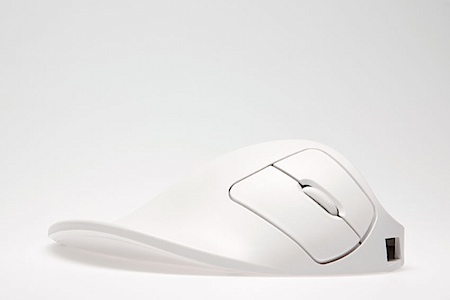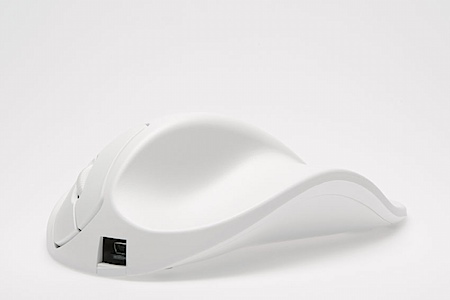
 The “Handshoemouse” was developed by scientists at the medical universities of Rotterdam and Maastricht. It’s meant to be ergonomic and it sure looks the part. I have used Logitech for many years now without much trouble. I had a bout of Repetitive Stress Syndrome years and years ago but I think that was more about the desk height than anything. This looks pretty nice, but it’s sad that you have to compromise all the special features (extra buttons, hyperscroll, etc.) to get the truly ergonomic designs. Still meaning to pick up a MX1100 to replace my old revolution. Via Hot Hardware
The “Handshoemouse” was developed by scientists at the medical universities of Rotterdam and Maastricht. It’s meant to be ergonomic and it sure looks the part. I have used Logitech for many years now without much trouble. I had a bout of Repetitive Stress Syndrome years and years ago but I think that was more about the desk height than anything. This looks pretty nice, but it’s sad that you have to compromise all the special features (extra buttons, hyperscroll, etc.) to get the truly ergonomic designs. Still meaning to pick up a MX1100 to replace my old revolution. Via Hot Hardware
Handshoemouse
10.16.2008



Looks like the hand rests very similarly to the way my Left hand (southpaw) sits on my Trackball Explorer. Feels very natural, although the handshoemouse looks a little big to be pushing around a desk.
I can put in a good word, no I mean a great, even fantastic word for the MX1100. You probably already now this, but it’s amazing, switched from my mighty mouse (apple, what where you thinking), and I’ve never been more satisfied about a mice.
Very elegant form…I’d really like to try it out. But “Handshoemouse” as a name? C’mon, I’m sure they could find some marketing folks to come up with something a bit snappier. Still, I’d give it a try if I had the money. I’ve been using the Logitech Vx Nano and I absolutely love the thing. It’s incredibly comfortable yet is small enough to travel with and has the tiniest USB receiver I’ve ever seen!
I guess the name “Handshoemouse” is a bit of a joke for Dutch people. Seeing as how the universities who’ve developed it are Dutch.
The Dutch word for glove (“handschoen”) directly translated to “handshoe” in english.
Professor Snijders as head of the department of Biomedical Physics and Technology of Erasmus MC, University Hospital Rotterdam and I studied the design of an ergonomic mouse. From this we concluded that gripping and pinching always go with activity of extensor muscles in the lower arm.
We therefore looked into a design which discourages this by means of adapting the shape of the computer mouse. This has resulted in the computer mouse by Hippus, The HandShoeMouse. The body of this computer mouse provides support for the hand like a saddle.
The virtue of the Hippus mouse proved to be the fact that one did not have to hold it, the contour of the body enabled a relaxed position of the hand without it slipping away. Moreover, as a result of the design of the contour, gripping was no longer possible.
After finalizing our field study, professor Han-Ming Chen of National Taiwan University provided additional information and confirmation of our findings in his publication “The effect on forearm and shoulder muscle activity in using different slanted computer mice” published in Clinical Biomechanics 22, 2007, 518-523.
http://www.hippus.nl/en/main/publicaties.php